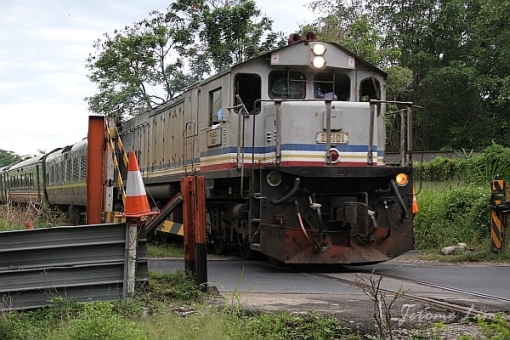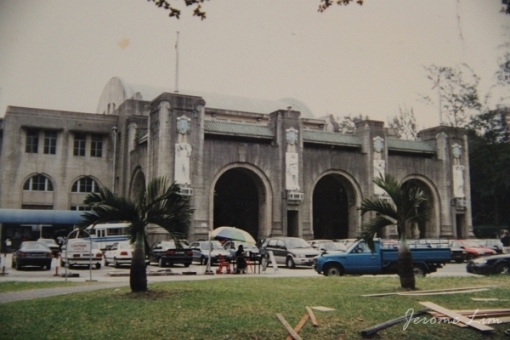The last level crossing in Singapore
By Jerome Lim, 19 May 2011.
Minutes before arriving at Woodlands on the 30th of June, the last of the Malayan Railway trains to cut across our island would have passed what would be the last operational level crossing in Singapore. It is probably appropriate that the crossing, one of two gated crossings left (the other being at Gombak Drive), is the last that will see a train pass through, being close to the terminal point of the original Singapore-Kranji Railway which commenced operations in 1903. The original line had featured numerous level crossings, particularly in the busy city centre and in planning the Railway Deviation of 1932, a stated objective had been the elimination of the level crossings in the city which proved not just to be costly to maintain, but also contributed to significant congestion on the city roads as well as being dangerous. What we are left with today are five operational manned level crossings, three of which are closed by a barrier rather than a gate. The crossings are at Gombak Drive, Choa Chu Kang Road (the widest), Stagmont Ring Road, Sungei Kadut Avenue and Kranji Road.

A train crossing Kranji Road. The Kranji level crossing would be the last one to operate on the 30th of June 2011. Read more
Don’t miss the last train!
By Jerome Lim, 18 May 2011.
The last day of June this year will bring to a close a long chapter in our history, one that will break a link we have had with the Malayan Railway, now operated by Keretapi Tanah Melayu (KTM), that went back some 108 years. The railway’s beginings can be traced back to the Singapore-Kranji Railway which started service in 1903 providing a link from the north down to the terminal station in Tank Road. A ferry service was introduced which provided rail passengers with a link to the Johor Railway across the Straits of Johor which was replaced by the rail link across the Causeway when that was built. It was a railway deviation in 1932 that diverted the railway to its current terminal at Tanjong Pagar, cutting a path through from Bukit Timah deviating from its original route over towards Ulu Pandan, Buona Vista, Tanglin Halt, towards the new grand terminal built to provide Singapore with a station that was befitting of its economic importance. Beside the grand old station, it was this deviation that possibly provided us with the many structures that give the areas through which the railway passes through a unique flavour as well as helping preserving parts of old Singapore: the two distinctive black truss bridges across Bukit Timah Road; the girder bridges across at the road entrance to Bukit Timah Hill and at the entrance to Hillview Avenue; the quaint old station at Bukit Timah and the wonderful green corridor that has been maintained along much of the railway land.

The last train will pass reach Woodlands Checkpoint at approximately 23:00 on 30th June 2011 and that will end 108 years of trains of the Malayan Railway chugging through Singapore. Read more
The last train from Tanjong Pagar
By Jerome Lim, 14 May 2011.
On the 30th of June, we will see the last day of operation at the grand old station at Tanjong Pagar. The station, grand not in terms of scale, but in the magnificent style in which it was built, has served Singapore as the southern terminal station for close to eight decades, having been completed in 1932 to provide a city fast growing in economic importance with a station befitting of its status, and being part of a deviation of the railway which had prior to that, run through the Bukit Timah corridor before terminating at Tank Road. With the return of the railway land which has been held on a lease by the successors of the Malayan Railway, Keretapi Tanah Melayu (KTM) and the shift of the southern terminal on the 1st of July, the age of rail travel across Singapore, which has lasted a little over a century, would draw to a close.

Operations at the grand building which has served as the southern terminal of the Malayan Railway since 1932 will cease on 1st July 2011.
In what form the station, which has recently received status as a National Monument, will be conserved following the handover we do not know, but whatever does happen, it would only serve as a reminder of the once working station which had for many years been an oasis of the laid back old world feeling that is missing from the modern Singapore that we have gotten used to. Gone will be the whistles and the drone of the diesel engines, the coming and going of passengers, the popular food outlets and what has become an institution at the railway station, the Habib Book Store and Money Changer. Gone will also be the opportunity to soak up the feel of the mood around the station, and lazily sip away at a cup of tea seated at the station end of the arrival platform. Read more
A colourful journey in black and white
By Jerome Lim, 14 March 2011.
I have always been one for train rides, taking one every opportunity I get whenever I find myself with time to spare, be it from the grand stations of the great European cities, or from stations closer to home, with a particular liking for the old style railways that I sometimes stumble upon. In Singapore, the opportunity had presented itself throughout my life I guess, but somehow, I never embarked on a journey from the grand old station at Tanjong Pagar until I was well into my adulthood, making many trips in the 1990s. Trains always present themselves as a convenient means to get around from one city to another, taking one from the centre of the city right into the heart of another. So it is with the Malayan Railway as well – for another few months at least when Keretapi Tanah Melayu Berhad (KTMB or KTM) moves the terminal station from Tanjong Pagar to Woodlands. With that, we will bid goodbye to the old railway lines which has served Singapore since the turn of the last century, as well as an old railway station in the heart of the city.

The last opportunity to take a train from an old style station in the heart of Singapore, on a line that has served Singapore since 1932 (parts of it date back to the turn of the last century), through Singapore’s countryside, before train services terminate at Woodlands by the time the 1st of July arrives.
As mentioned in my previous post, I took another ride recently, just for the sake of reliving my previous journeys before the chance to do so evaporates once KTM moves operations to Woodlands. It will be a shame not to have had that experience, one that involves arriving or departing from the platforms which had served as the southern terminal to the Malayan Railway for eight decades from its days as the FMSR. Once the move is made, Singapore would lose not just another historical link it has had with the Malay States in the Malayan Peninsula, but also a proper train station to take a romantic journey on a train from. What will also go are the well worn tracks that served us so well, laid over a corridor of land that probably due to the railway, has remained untouched and relatively green; as well as the many markers left behind by the railway including the railway bridges, signal posts, railway buildings and control huts, distance markers and the last remaining level crossings in Singapore. Read more
There I go again … another journey through Tanjong Pagar
By Jerome Lim, 11 March 2011.
I guess I have not had enough of it, despite probably having tens of, if not a couple of hundred journeys out of Tanjong Pagar. I did it once again, since proclaiming that that journey taken with some friends at the end of last year would possibly have been my last. Having had a mixed bag of experiences on the many journeys through the arches of the grand old station, the ones that probably I remember most of are the regular delays that one comes to expect on the far from reliable train service that KTMB operates. Part of the reason for this, some of the archaic infrastructure and practices still in use on the old railway, does perhaps lend itself to an experience that you would certainly not get on the efficient railways that criss-cross much of the European continent – one that seems out of place in the ultra modern and efficient world we have grown accustomed to in Singapore.

I will certainly miss taking train journeys out of Tanjong Pagar … something that will perhaps motivate me to take a few more over the next few months before the station closes.
Stepping into the station itself would somehow take you back in time, the atmosphere being one which seems more at home in the Singapore of the 1960s and 1970s. The large airy concourse that greets the visitor is adorned with mosaic murals that speak of a style that was prevalent of a time we have left behind and depict scenes from the Malayan peninsula that would have been more common in that era. Over the years that I had have an awareness of the layout of the concourse, nothing much has changed except perhaps that the occupants of some of the spaces, and an invasion of a Tourism Malaysia hut in the middle of it. It is in one of the spaces along the concourse that some nice food can be found and to perhaps add a old world flavour to the station, you would find food vendors that would be more comfortable conversing in Bahasa Melayu, once a common language on the streets. Read more
Journeys through Tanjong Pagar: First Impressions …
By Jerome Lim, 21 Sep 2010.
I had as a child, been fascinated by the old railway station at Tanjong Pagar. The grand old station building, which has provided many of us with a passage to the north, had been one that always attracted my attention whenever I passed it in the backseat of my father’s car. The very first impression I have of the station is one that has been shaped by the food stalls that sprouted up in the open air car park in front of the station every evening, stalls that seemed to glow in the shadows cast by the grey façade of the railway station.































